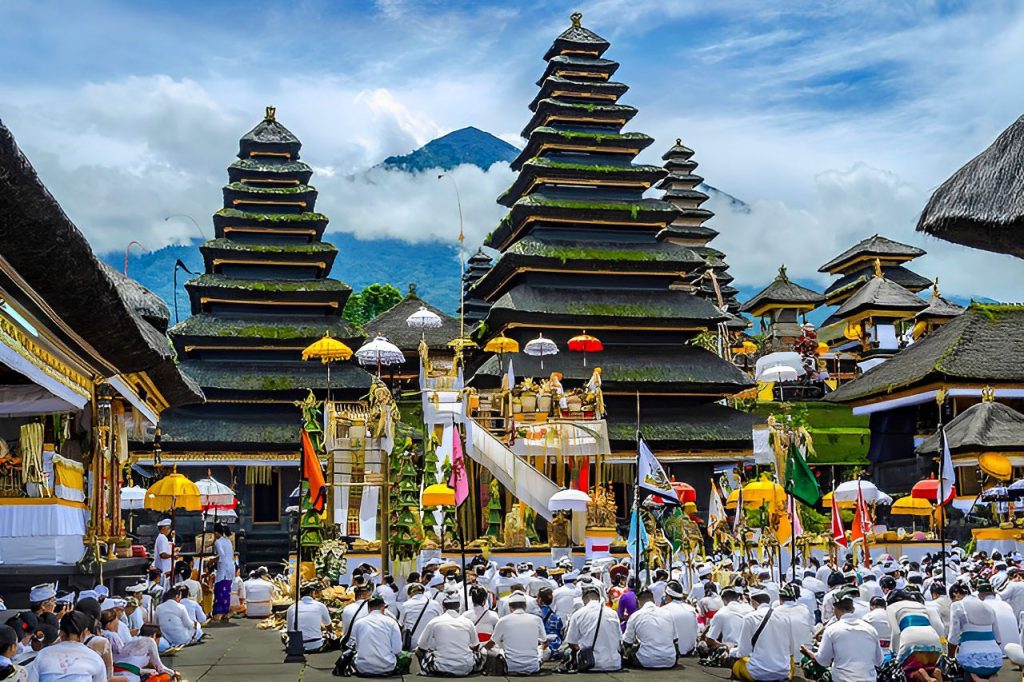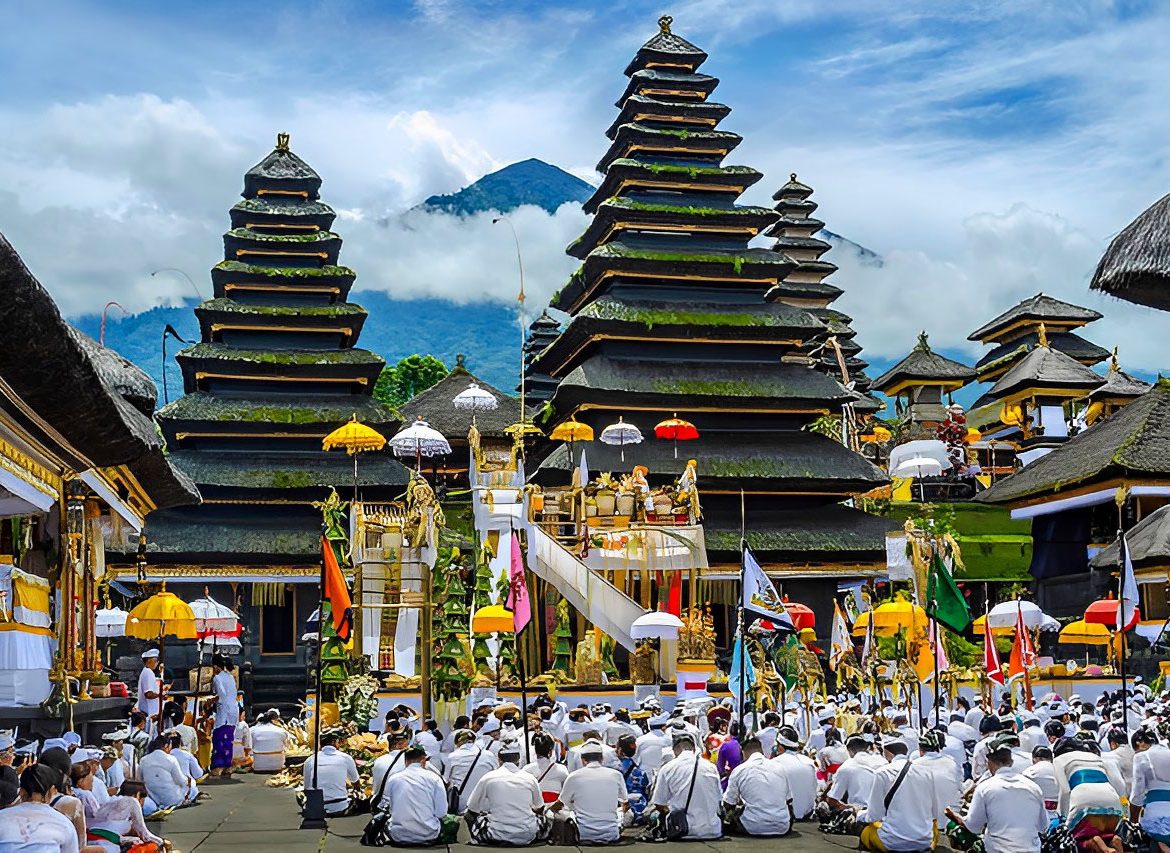Pura Besakih: Bali’s Mother Temple and Its History

Pura Besakih is the most significant temple on the island of Bali, Indonesia. It is also referred to as Pura Agung Besakih and the Mother Temple of Bali. It is an important place of pilgrimage for Hindus living in Bali as it is regarded as the spiritual epicenter of their religion. Pura Besakih is a cultural and spiritual gem of Bali. It is known for its magnificent architecture, intricate layout, and rich history. In this essay, we will delve into the intriguing history of Pura Besakih by tracing its beginnings all the way back to the distant past and continuing on into the modern day.
Early History of Pura Besakih
When a Hindu philosopher by the name of Markandeya came in Bali from Java in the eighth century, the history of the Pura Besakih may be traced back to that time. The story goes that Markandeya was looking for a quiet spot to meditate and establish a connection with the gods. He decided to make his residence on the slopes of Mount Agung, which is the highest peak in Bali, and he constructed a modest shrine there in honor of the god of the mountain, who is known as Hyang Api.
Mount Agung’s breathtaking scenery and potent spiritual force drew an increasing number of Hindu priests and pilgrims to the mountain over the course of history. Around the primary shrine that Markandeya had constructed, they constructed additional shrines and temples, thereby creating a sacred complex that would one day become the Besakih Temple.
Developments and Expansions
New temples, courtyards, and pavilions were added to the Pura Besakih complex over the course of several centuries, resulting in the temple’s continued growth and expansion. The temple was originally devoted to Hyang Api, the god of Mount Agung; however, over the course of time, other deities were added, reflecting the diverse beliefs and outside influences held by the people of Bali.
The Majapahit Empire, a powerful Hindu-Buddhist kingdom in Java, conquered Bali in the 15th century and brought a new wave of religious and cultural influences with it. These influences can be seen to this day in Bali. The rulers of the Majapahit dynasty were instrumental in the construction of the Besakih Temple and made significant contributions to the temple’s iconography and architecture.
The history of Pura Besakih, on the other hand, has not been free of difficulties. The temple has suffered damage on multiple occasions over the course of the centuries, the most notable of which occurred in 1917 and 1963, when earthquakes and volcanic eruptions caused the temple complex to sustain significant damage. In spite of these obstacles, the people of Bali have always shown remarkable resiliency in their efforts to restore and maintain Pura Besakih.
Significance and Cultural Roles
Because Balinese Hindus consider Pura Besakih to be the abode of the gods, visiting the temple is considered to be an important part of their religious practice. The grandeur of the temple’s architecture, the intricacy of the rituals and ceremonies that take place there, and the awe and respect with which the locals regard the temple are all indications of its importance to the Balinese people.
Animism, ancestor worship, and Buddhist and Javanese influences are all incorporated into the distinctive style of Hinduism practiced on Bali. This makes Balinese Hinduism a truly one-of-a-kind kind of Hinduism. The religion is characterized by a complicated system of rituals, offerings, and ceremonies, and the Balinese people place a great deal of importance on maintaining a harmonious relationship between the spiritual world and the material world.
Visitors to Pura Besakih have the opportunity to observe the temple’s daily rituals and ceremonies, which include the presentation of offerings of flowers, rice, and incense. They can also observe more significant events, such as the celebration of the temple’s anniversary or a full moon ceremony.
Architecture and Layout
Pura Besakih is actually a complex that consists of twenty-three different temples that are built on six different levels and have a total of over 80 different buildings. The temples are laid out in a linear axis, and visitors can walk along a path that leads them through the many different levels and structures that make up the complex.
The layout of Pura Besakih, which features a number of courtyards, pavilions, and shrines, is quite intricate and is a combination of Javanese and Balinese architectural styles. Each of the temples that make up Pura Besakih is devoted to a different deity or deities, and each temple has its own set of distinguishing characteristics and meanings.
The principal temple of Pura Besakih is known as Pura Penataran Agung, and visitors can find it at the very top of the complex. This temple is the largest and most important of all the temples in the complex. It is devoted to Hyang Api, the god of the mountains. A raised platform serves as the foundation for the temple, which is encircled on all sides by smaller shrines and pavilions. Visitors have the option of climbing the stairs to reach the highest point of the temple, where they will be rewarded with breathtaking vistas of the region.
Pura Batu Madeg is an additional significant temple found within Pura Besakih. It is dedicated to Dewi Sri, the god of agriculture. This temple, which can be found on the third level of the complex, is famous for the intricate carvings and sculptures that adorn its interior. In addition, the temple is home to a number of holy pools, which serve as locations for various rituals of cleansing for visitors.
Restorations and Preservations
Pura Besakih has been beset by a variety of difficulties over the course of its history, ranging from natural disasters to political unrest. Pura Besakih, on the other hand, is not an exception to the fact that the Balinese people have always been committed to restoring and preserving their cultural heritage.
A significant restoration project was carried out at Pura Besakih in the early 20th century by the Dutch colonial government. This project assisted in the preservation of a significant number of the temple’s structures as well as artifacts. In the decades that have passed since then, the local communities of Bali and the Balinese government have continued their efforts to restore and preserve the temple. These efforts have ensured that the temple will continue to serve as an important cultural and spiritual center for future generations.
Visiting Pura Besakih
A trip to the Pura Besakih is an experience that will stay with you forever because it provides a glimpse into the diverse history and culture of Bali. It is essential to dress appropriately and conduct yourself respectfully if you want to get the most out of your visit. Before entering the temples, guests are required to remove their shoes, dress modestly in clothing that covers their shoulders and knees, and cover their heads.
It is also a good idea to hire a local guide or sign up for a tour in order to acquire a deeper comprehension of the significance of the various temples and structures contained within the complex. In addition, tourists should be aware of their surroundings at all times and take the necessary precautions to protect themselves, particularly during times of increased volcanic activity.
Tips on Visiting Pura Besakih
Dress Appropriately
As was mentioned earlier, visitors to the temple are asked to dress respectfully and cover their shoulders and knees during their time there. Not only is this act respectful, but it is also necessary in order to enter the temples.
Hire a Local Guide
It is recommended that you hire a local guide or participate in a tour in order to gain a better understanding of the significance of the temple’s location. They will be able to enlighten you on the background of the complex as well as the significance of the various temples and structures that make up the area.
Respect Sacred Spaces
Visitors are reminded that Pura Besakih is a sacred location and should conduct themselves in a respectful manner while inside. Visitors should not touch any of the statues or offerings, and they should always ask permission before taking photographs of the priests or any ceremonies.
Take Safety Precausions
Be sure to exercise caution, as Pura Besakih can be found on the slopes of the active volcano Mount Agung. Prior to their visit, tourists are advised to research the area’s current level of volcanic activity and comply with any directives issued by the authorities in the area.
Visit Pura Besakih Early
If you want to avoid the heat and crowds, the best time to go to Pura Besakih is first thing in the morning. The temple complex is open for business beginning at 8:00 in the morning, and the optimal time to go is before 10:00 am.
Final Thoughts on the History of Pura Besakih
Not only is Pura Besakih a remarkable cultural and spiritual site, but it also serves as a symbol of the Balinese people’s tenacity and dedication to their cultural heritage. The temple is one of the most important cultural landmarks on Bali due to its long history, which spans several centuries, as well as its magnificent architecture and intricate layout.
A trip to Pura Besakih is an experience that will stay with you forever because it provides a window into the distinctive practices and beliefs of the Balinese people. Visitors can have a meaningful and enlightening experience at this holy site by coming prepared and behaving in a respectful manner while they are there.
Pura Besakih should absolutely be on everyone’s to-do list while in Bali, regardless of whether they are interested in religion, history, or simply want to get a taste of the island’s vibrant culture. It should come as no surprise that Pura Besakih, which is located in Bali, is referred to as the island’s Mother Temple due to the awe-inspiring architecture, ornate carvings, and significant cultural and spiritual importance it possesses.
Visitors are able to acquire a more profound appreciation for the distinctive beliefs and practices of the Balinese people if they take the time to learn about the temple’s past and its significance. Anyone who goes to Bali absolutely needs to make time to stop by this temple because of its long and illustrious history, as well as the breathtaking natural surroundings.
In conclusion, Pura Besakih is an extraordinary cultural and spiritual treasure that has endured hundreds of years of natural disasters and political upheaval. In spite of these obstacles, the people of Bali have persevered in their efforts to restore and preserve their cultural heritage. This has ensured that the Besakih Temple will continue to serve as an important cultural and spiritual center for future generations.
A trip to the Pura Besakih in Bali is a profound and enlightening experience that provides a window into the island’s illustrious past and vibrant culture. Visitors have the ability to ensure a visit to this holy site is one that is filled with respect and significance by adhering to the advice provided in this guide.
Finally, if you are looking for official information about Pura Besakih, you can visit the official website of the Regency Administration of Karangasem.


